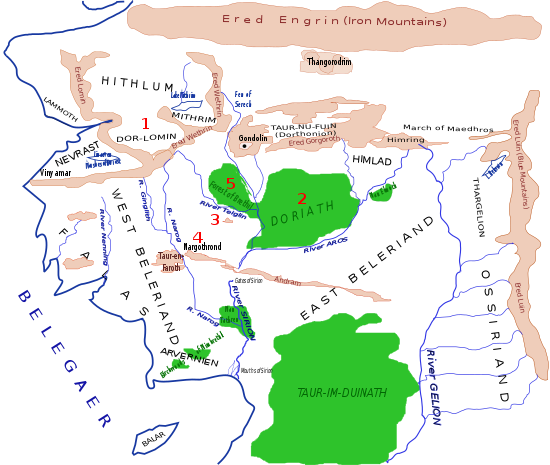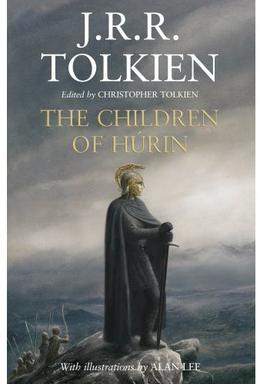Narrative
Dor-lómin

1 Dor-lomin; 2 Doriath; 3: Amon Rûdh; 4: Nargothrond; 5: Brethil
Túrin is the son of Húrin, Lord of the Folk of Hador, and Morwen of the House of Bëor. [T 2] The Siege of Angband has been broken, but Túrin's homeland of Dor-lómin in the northwest of Beleriand is still contested by Húrin against the Dark Lord Morgoth's forces. When Túrin is eight, Húrin leads his Men to war; all are killed in the Battle of Unnumbered Tears. Húrin is captured and cursed by Morgoth, who sends an army of Easterlings to Dor-lómin. Túrin remains with Morwen, who hides him and sends him secretly to the hidden Elven-realm of Doriath; Morwen remains in Dor-lómin, and shortly afterwards gives birth to a girl, Niënor. [T 3] [T 4]
Doriath
Túrin reaches Doriath, which is protected by an enchantment, the Girdle of Melian. The marchwarden Beleg leads them to the city of Menegroth, where King Thingol adopts Túrin, in memory of Húrin's heroism. The Elven-lady Nellas watches over Túrin at Melian's bidding, teaching him Elven-lore. Túrin becomes esteemed for his prowess, and Beleg teaches him warfare. When after some years Dor-lómin is cut off and news from Morwen and Niënor ceases to arrive, Túrin decides to pit his strength against Morgoth's forces, hoping to avenge the sorrows of his kin. Thingol appoints him a "knight of the sword". [T 5] Túrin departs to fight the Orcs in the north of Doriath, where he is joined by Beleg. His chief weapon is the sword, and he wears the Dragon-helm of Hador, so that the Orcs fear him. At the age of 20, [T 5] [T 6] Túrin accidentally kills Saeros, one of Thingol's counsellors, who had insulted him. Ignoring advice, he flees from Doriath, fearing imprisonment. Thingol pardons Túrin, and Beleg obtains leave to seek out his friend. [T 4]
Amon Rûdh
Túrin, unaware of this, flees westward, joining a band of outlaws in Gaurwaith and becomes its leader by accidentally killing their captain. [T 7] Beleg finds the band in the wild, but Túrin rejects Beleg's advice to return to Doriath. Túrin's band captures Mîm the Petty-dwarf. To save his life, Mîm shares his dwellings on the hill of Amon Rûdh with the band. Beleg returns to Túrin, bringing the Dragon-helm. The "Two Captains" free much of West Beleriand from evil, but the Dragon-helm reveals Túrin's identity to Morgoth, who attacks Amon Rûdh. [T 6] The Orcs find Mîm, and he buys his life by leading them up the hill. Túrin is captured and all his men killed; Beleg escapes. [T 8] Beleg follows the Orcs through the forest of Taur-nu-Fuin, and meets Gwindor, an escaped slave from Angband. Together they rescue Túrin in Anfauglith. Unfortunately, while Beleg is cutting the sleeping Túrin free from his bonds, he pricks Túrin's foot with the black sword Anglachel. Túrin, mistaking him in the darkness for an Orc, takes the sword and kills Beleg. Gwindor leads the grief-stricken Túrin to the Pools of Ivrin, where he returns to his senses. [T 4]
Nargothrond
They journey to the hidden fortress of Nargothrond, where Gwindor had been a lord. He gives Beleg's sword Anglachel to Túrin, who has it reforged and renamed Gurthang, "Iron of Death". Túrin hides his own name, becoming known as Mormegil or the Blacksword of Nargothrond. Gwindor meets his beloved, Finduilas daughter of King Orodreth, but she unwillingly falls in love with Túrin; Túrin does not perceive this and holds her in awe. Túrin becomes a chief counsellor to the King. He encourages the Elves to abandon their secrecy, and they build a great bridge before the Doors of Nargothrond and clear the land between the River Sirion and the coastal Falas from enemies. Túrin becomes arrogant, ignoring even a warning from the godlike Vala Ulmo to destroy the bridge and return to secrecy. [T 3]
After five years, Morgoth sends a great host of Orcs led by the dragon Glaurung. Túrin persuades Orodreth to fight them in the open. In the ensuing Battle of Tumhalad, Nargothrond's forces are destroyed and Orodreth is killed; the bridge helps Morgoth's forces to locate the fortress and cross the river Narog. Túrin fights Glaurung off, but leaves the battle to carry away the mortally wounded Gwindor. Before Gwindor dies, he instructs Túrin to save Finduilas, prophesying that she alone can avert Túrin's doom. Hastening to save the captives, Túrin is caught by Glaurung's powerful gaze. He stands by enspelled as Finduilas is dragged away, calling to him. The dragon deceives him into believing that Morwen and Niënor are suffering in Dor-lómin; Túrin abandons Finduilas to seek out his kin. When he reaches Dor-lómin, he finds that Morwen had already left for Doriath before the fall of Nargothrond. In his rage he kills the people around him. [T 4]
Brethil
Túrin next tries to find Finduilas, travelling to the forest of Brethil, but is too late: the woodmen inform him that she had been killed by the Orcs when the Men of Brethil tried to rescue her. Túrin collapses in grief upon her grave, and is brought to a village in the forest, Ephel Brandir. There he takes up his life again, now calling himself Turambar ("Master of Doom") and renouncing his descent, hoping to overcome his curse. The Folk of Haleth dwelling there are ruled by Brandir the Lame, who hopes to preserve his people by secrecy. Turambar quickly gains power, gathering companies to fight Orcs. He stops wielding Gurthang and fights using a spear and a bow. [T 4]
When Morwen and Niënor hear the news of Nargothrond's destruction, they rashly go to look for Túrin. Glaurung, now living in the ruins of Nargothrond, descends into the river to create a fog. Morwen loses her way in the fog, but Niënor meets the dragon and is enspelled by him, forgetting her past. She flees to Brethil. Turambar finds her at Finduilas's grave, naked, unable to speak and remembering nothing. He names her Níniel, "Maid of Tears", and takes her to Ephel Brandir. There she is healed by Brandir, who falls in love with her; but Níniel and Turambar come to love each other. Turambar asks her to marry him; Brandir dissuades her, foreboding evil, but they are married. Turambar goes back to war when Glaurung sends Orcs to attack Brethil: taking up the sword again, Turambar drives them away. Next year Níniel conceives, and Glaurung attacks Brethil in person. [T 4]
Turambar decides to ambush the Dragon and to try stabbing him from beneath. Of his two companions, Dorlas deserts, and Hunthor is killed by a stone. Turambar mortally wounds Glaurung with Gurthang, but is poisoned by the Dragon's blood and falls in a swoon. When Níniel comes to search for him, Glaurung with his last words undoes his spell, and she remembers who she is, and that Turambar is her brother. Horrified, Niënor drowns herself in the river Teiglin. [T 4]
Brandir tauntingly tells Turambar what has happened. Turambar kills the defenceless Brandir and runs in madness to Finduilas's grave. There an Elf of Doriath, Mablung, confirms the words of Brandir. Turambar flees and kills himself with Gurthang. He is buried in a high mound, together with the shards of the sword. A great stone is set upon the grave, upon which the Elves write in Cirth runes: [T 4]
TÚRIN TURAMBAR DAGNIR GLAURUNGA
NIËNOR NÍNIEL
(Túrin, Conqueror of Fate, Slayer of Glaurung
Niënor Níniel)
However, Niënor's body is not there. Two years later Morwen and Húrin meet there for the last time; Morwen is later buried there. The mound survives the War of Wrath and the Drowning of Beleriand; Tol Morwen becomes an island off the coast of Middle-earth. [T 4]
Fate after death
Tolkien wrote several versions of a prophecy about Túrin's fate after death.
The fragmentary earliest outline mentions "purification of Turambar and Vainóni who fare shining about the world and go with the hosts of Tulkas against Melko." [T 9] In the finished manuscript of The Tale of Turambar and the Foalókë , this becomes a story that Túrin and Niënor were only admitted to Mandos after their parents' prayers; they entered the "bath of flame", where the Sun replenished its light, "and so were all their sorrows and stains washed away, and they dwelt as shining Valar among the blessed ones." A new detail is introduced, that "Turambar indeed shall stand beside Fionwë in the Great Wrack, and Melko and his drakes shall curse the sword of Mormakil". [T 9]
In Tolkien's later writings, Niënor's fate is not mentioned, but Túrin's destiny is made even more prominent. Túrin would take part in the Last Battle before the End of the World, when Morgoth would return and make the final assault upon the Valar and the Children of Ilúvatar. In the "Earliest Silmarillion", "the spirit of Túrin" comes back and fights, and "it shall be Túrin who with his black sword will slay Morgoth", [T 10] elaborated in the 1930 revision of the Quenta Noldorinwa . [T 11]
Line of Túrin and Niënor
| Túrin–Tuor family tree [T 12] | |||||||||||||||||||||||||||||||||||||||||||||||||||||||||||||||||||||||||||||||||||||||||||||||||||||||||||||||||||||||||||||||||||||||||||||||||||||||||||||||||||||||||||||||||||||||||||||||||||||||||||||||||||||||||||||||||||||||||||||||||||||||||||||||||||||||||||||||||||||||||||||||||||||||||||||||||||||||||||||||||||||||||||||||||||||||||||||||||||||||||||||||||||||||||||||||||||||||||||||||||||||||||||||||||||||||||||||||||||||||||||||||||||||||||||||||||||||||||||||||||||||||||||||||||||||||||||||||||||||||||||||||||||||||||||||||||||||||||||||||||||||||||||
|---|---|---|---|---|---|---|---|---|---|---|---|---|---|---|---|---|---|---|---|---|---|---|---|---|---|---|---|---|---|---|---|---|---|---|---|---|---|---|---|---|---|---|---|---|---|---|---|---|---|---|---|---|---|---|---|---|---|---|---|---|---|---|---|---|---|---|---|---|---|---|---|---|---|---|---|---|---|---|---|---|---|---|---|---|---|---|---|---|---|---|---|---|---|---|---|---|---|---|---|---|---|---|---|---|---|---|---|---|---|---|---|---|---|---|---|---|---|---|---|---|---|---|---|---|---|---|---|---|---|---|---|---|---|---|---|---|---|---|---|---|---|---|---|---|---|---|---|---|---|---|---|---|---|---|---|---|---|---|---|---|---|---|---|---|---|---|---|---|---|---|---|---|---|---|---|---|---|---|---|---|---|---|---|---|---|---|---|---|---|---|---|---|---|---|---|---|---|---|---|---|---|---|---|---|---|---|---|---|---|---|---|---|---|---|---|---|---|---|---|---|---|---|---|---|---|---|---|---|---|---|---|---|---|---|---|---|---|---|---|---|---|---|---|---|---|---|---|---|---|---|---|---|---|---|---|---|---|---|---|---|---|---|---|---|---|---|---|---|---|---|---|---|---|---|---|---|---|---|---|---|---|---|---|---|---|---|---|---|---|---|---|---|---|---|---|---|---|---|---|---|---|---|---|---|---|---|---|---|---|---|---|---|---|---|---|---|---|---|---|---|---|---|---|---|---|---|---|---|---|---|---|---|---|---|---|---|---|---|---|---|---|---|---|---|---|---|---|---|---|---|---|---|---|---|---|---|---|---|---|---|---|---|---|---|---|---|---|---|---|---|---|---|---|---|---|---|---|---|---|---|---|---|---|---|---|---|---|---|---|---|---|---|---|---|---|---|---|---|---|---|---|---|---|---|---|---|---|---|---|---|---|---|---|---|---|---|---|---|---|---|---|---|---|---|---|---|---|---|---|---|---|---|---|---|---|---|---|---|---|---|---|---|---|---|---|---|---|---|---|---|---|---|---|---|---|---|---|---|---|---|---|---|---|---|---|---|---|---|---|---|---|---|---|---|---|---|---|---|---|---|---|---|---|---|---|---|---|---|---|---|---|---|---|---|---|---|---|---|---|---|---|---|---|---|---|---|---|---|---|---|---|---|---|---|---|---|---|---|---|---|---|---|---|---|---|---|---|---|---|---|---|---|---|---|---|---|---|---|---|---|---|---|---|---|---|---|---|---|---|---|---|---|---|---|---|---|---|---|---|---|---|---|---|---|---|---|---|---|---|---|---|
| |||||||||||||||||||||||||||||||||||||||||||||||||||||||||||||||||||||||||||||||||||||||||||||||||||||||||||||||||||||||||||||||||||||||||||||||||||||||||||||||||||||||||||||||||||||||||||||||||||||||||||||||||||||||||||||||||||||||||||||||||||||||||||||||||||||||||||||||||||||||||||||||||||||||||||||||||||||||||||||||||||||||||||||||||||||||||||||||||||||||||||||||||||||||||||||||||||||||||||||||||||||||||||||||||||||||||||||||||||||||||||||||||||||||||||||||||||||||||||||||||||||||||||||||||||||||||||||||||||||||||||||||||||||||||||||||||||||||||||||||||||||||||||








